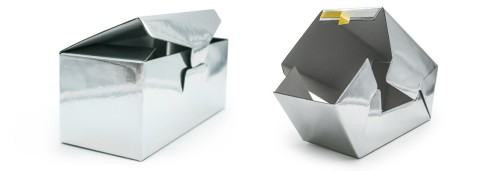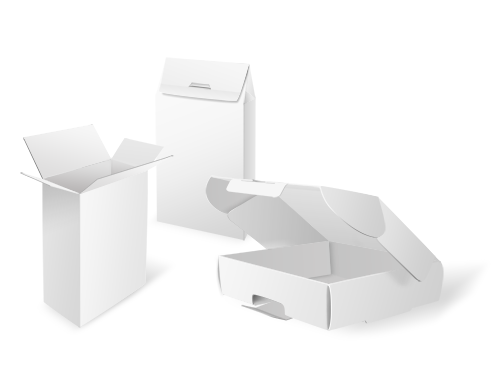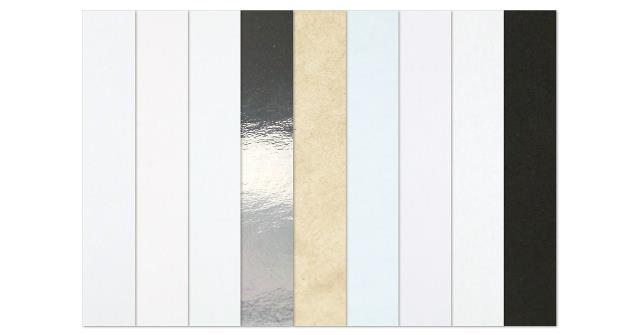GC1 - coated chromo board
The GC1 board is a so-called chromo board. The chromo board is a multi-ply board made of pulp, wood pulp or wood-free waste paper with a coated, flat surface. GC1 chromo board is a primary fiber board. Primary fiber means that the board is made from virgin fibers rather than recovered paper. A chromo board has a high strength of the paper material and is therefore often used for folding boxes instead of corrugated board, solid board or other fine cardboard.
Discover also our range of labels.
The first letter of the designation GC1 describes the surface, the G stands for coated. The second letter describes the raw material used, the C of GC1 stands for chromo board, made from primary fibers. The material used for the GC1 comes from FSC certified sustainable forestry. The digit determines the color of the reverse side and the weight of the front side. There are two different types of chromo board to choose from in the folding carton calculator on Labelprint24. On the one hand the GC1 chromo cardboard as well as the GC2 chromo cardboard. The 1 stands for a cardboard with white back, which is mostly smooth. The 2 of the GC2 stands for a bright back, which is slightly rough.
The GC1 chromo board has a double white coated front side. The pigment coating enables a printed image with a brilliant color effect. Thanks to the white coating on the front, finishes and varnishes have a higher gloss effect than on uncoated board. The GC1 can therefore be used to produce visually very high-quality folding cartons with high print quality. The GC1's coating is white, so it leaves plenty of room for creativity; almost any design, no matter how colorful or plain, can be realized for you on our GC1, or any other cardboard material from our calculator, using the digital printing process.
In addition to the standard white GC1 chromo board, you have the option of selecting a silver GC1 chromo board for your folding boxes. This special GC1 has a smooth white reverse side and is silver foiled over the entire surface on the front. This creates a special feel due to the smooth foil and a particularly striking look due to the mirror effect.
Learn more about the silver GC1 chromo board
In the folding box calculator on Labelprint24 you have the option to choose between chromo board in different grammages and thicknesses. The chromo board already has a high bending stiffness in all grammages, with increasing grammage the strength of the material also increases. For small boxes, a GC1 with a low grammage, such as 215 g/m², is suitable, as the board has a thickness of only 0.3155 mm. Larger folding boxes for heavier products should be made from a chromo board with a higher grammage, such as 275 g/m², 325 g/m² or 350 g/m².
The GC1 is suitable for product packaging in all possible shapes and sizes. It can be used for almost any application. Among other things, it is suitable for use as pharmaceutical, food and toy packaging. Due to the wide range of different grammages and thicknesses as well as the excellent printability of the GC1 chromo board, the material can be used for any type of folding box, from hanging boxes to blanks, as well as for any type of application, whether as gift packaging, product packaging or give-away boxes.
Discover our entire range of folding boxes; each type of box can be configured in all grammages and thicknesses. Of course, we also offer a variety of other folding box materials that you can choose between in the calculator.
These articles may also interest you:

Silver cardboard for folding boxes
In today's age of self-service, packaging must sell the product. Whether a customer is attracted to a package depends on its color, shape, function and size.

The role of the folding carton in online retailing
Consumers who shop online pay close attention to product quality, freshness, deliverability, selection, and reliable service - all of which labels and folding cartons must provide.

The history of the folding box
Nowadays, it's hard to imagine a world without shipping cartons. We may take the folding box for granted today, but at the end of the 19th century it was way ahead of its time.












 Roll labels request form
Roll labels request form  Booklet labels request form
Booklet labels request form  Folding boxes request form
Folding boxes request form  Custom made shipping boxes request form
Custom made shipping boxes request form  Package leaflets request form
Package leaflets request form  Laminate tubes request form
Laminate tubes request form 






















